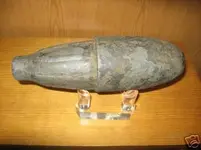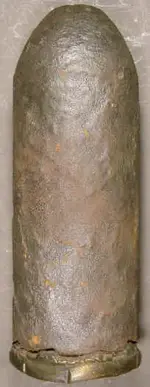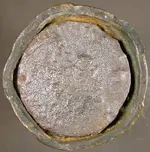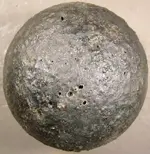Castletonking wrote:
> How old does iron need to be, before its black all the way through,almost crystalized and fragile as glass?
Your description of the iron you are finding -- black or greyish black, and brittle -- sounds like some the characteristics of Graphitized iron. (But I can't be certain without seeing several close-up photos of it.)
I learned about "Graphitized" buried iron nearly 40 years ago, shortly after the first time I'd dug some very strangely corroded cannonballs from a swampy creek. I was of course accustomed to seeing dug-up iron relics with the usual orange-brown rustcrust covering them. But my cannonballs from the swamp had a very thick smooth-ish orange "cocoon" covering them. When I whacked the cocoon with my shovel, it broke off fairly easily, revealing amazingly clean smooth greyish-black iron. But the iron was literally soft. When I made a small scrape on it with my shovelblade, the result was a silvery streak, the exact same color as pencil-lead. Also, in some spots my cocoon-bashing had broken small chunks of the soft, "brittle" iron out of the cannonball's original surface. The iron I saw in those bash-craters looked like very tiny grainy dark-grey crystals.
So, back in the mid-1970s, I asked my oldtimer civil war artillery shell Mentor about the strange condition of my swampy-creek cannonballs. He told me about the chemical process which is called Graphitization of buried iron, and he said that the acidic swampwater had "Graphitized" the iron surface of my cannonballs.
Graphite is a carbon-based mineral, and it is what pencil-lead is made of. The term "Graphitized" is somewhat misleading, because the iron does not get transformed (turned into) Graphite. Iron-ore naturally contains a significant percentage of Graphite. Therefore, even refined cast-iron (and wrought-iron, etc) is not actually 100%-pure iron.
Here is the explanation of what happens in the "Graphitization" of iron which is buried in a wet-dirt environment (such as a swamp, marsh, or OTHER "low-ground" location. Vegetable matter (plant-leaves and stems, etc) get into the water, and rot. The plant-parts contain a chemical called Tannic Acid, which gets into the water as the leaves rot. The Tannic Acid in the stagnant groundwater (swamp, marsh, very slow-moving creek) is so diluted by the water that the acid is quite weak... it won't burn your skin or even your eyes if you go swimming in the swampwater. But when iron is exposed to it for DECADES, it has a corrosive effect.
What happens is that the Tannic Acid slowly "leaches" iron molecules out of the buried iron's surface ...and what remains behind is the Graphite in the iron ...because Tannic Acid has no effect on Graphite. In many cases (but not always) the iron molecules which got removed by the Tannic Acid will "petrify" the dirt (or sand) which surrounded the buried relic, creating a hard "cocoon" around the iron relic's body. Please note, if the cocoon is not very thick, it can easily break off while you're digging/prying the relic out of the bottom of the hole. Several times, I've dug a "Graphitized" civil war artillery shell or other relic that came out of the hole with no cocoon on it ...but instead, just showing a smooth greyish-black surface. Being accustomed to the the usual orange/brown look of rust-crusted dug iron, it's quite a surprise to see the mostly-clean greyish-black iron ...until you learn about "Graphitization" of buried iron.
I should mention that the EXTENT (slight, light, moderate, severe) of Graphitization can vary a lot ...depending on the amount of Tannic Acid in the water, and how long the iron is in the ground. Fortunately, severe Graphitization is rare. But on that note, I own a 6-pounder caliber cannonball which was found by scuba divers on a civil war shipwreck. That ball, which originally weighed 6 pounds, now weighs less than 2 pounds ...even though the ball is still the same size as it was when it was made (approximately 3.58-inches in diameter). Apparently, it was in a cargo-hold next to the ship's coal bunker. Coal consists of compressed CONCENTRATED vegetable matter. Thus, coal is very rich in Tannic Acid ...which had a severe effect on the iron relics in the cargo-hold next to the coal bunker.
If you want to learn more about Graphitization of buried iron (which is a big problem for buried iron waterpipes), go here:
Technical Publication: Corrosion Sensors for Detecting Graphitization of Ca
A final, very important note:
Do NOT use Electrolysis (or Zinc-&-Lye bath) on a Graphitized iron relic. The graphitized surface of the relic will "dissolve" ...and the result will look quite ugly. To clean a Graphitized relic, you should VERY gently tap off any crust on it, and then coat it in Polyurethane.
Here are some photos of swampy-creek and wet/low-ground dug Graphitized iron artillery shells. The first photo shows a Graphitized 3"-caliber Schenkl shell, looking exactly as it did when it came out of the muck, exceprt that is has been washed off. The 2nd and 3rd photos show a Graphitized 20-pounder Parrott shell which was run trhough Electrolysis, thereby losing about 1/4" of its original surface. The 4th photo shows a Graphitized 12-pounder Solid-Shot cannonball after the orange petrified-dirt cocoon had been removed and the black dust under it had been washed/scrubbed off.







